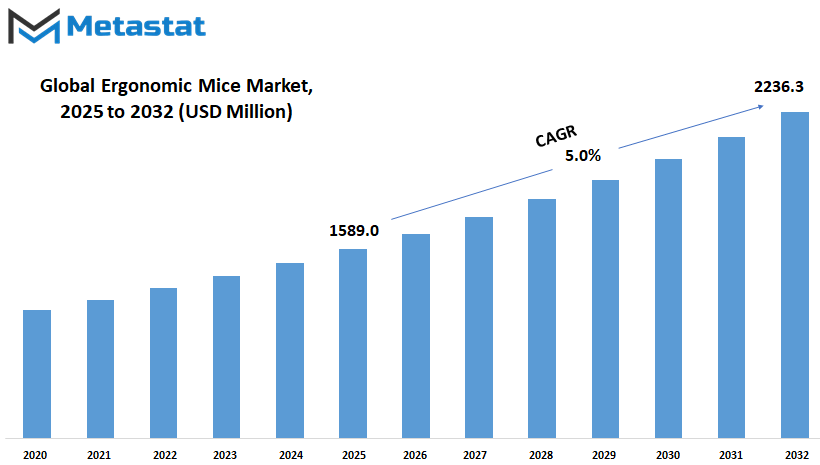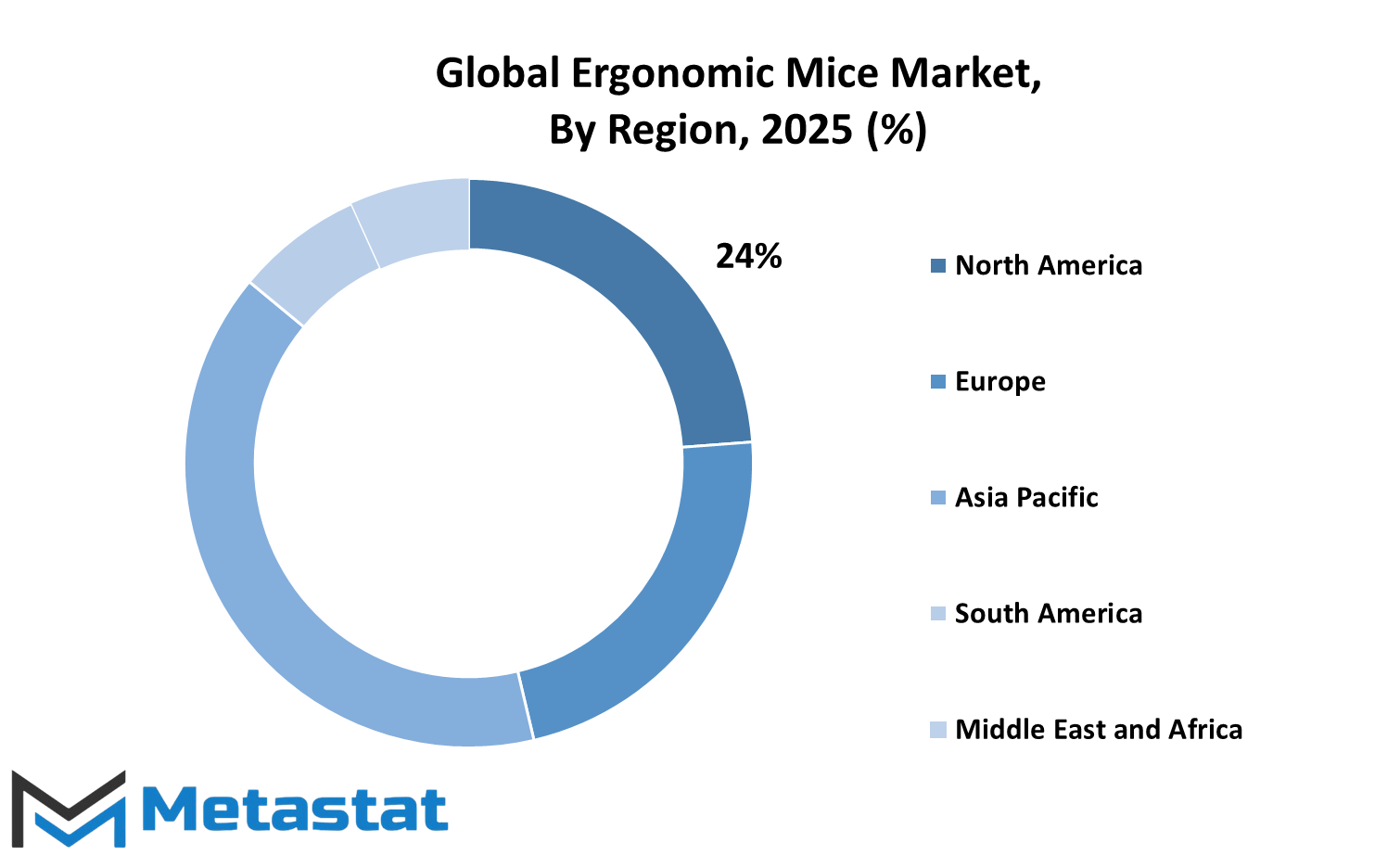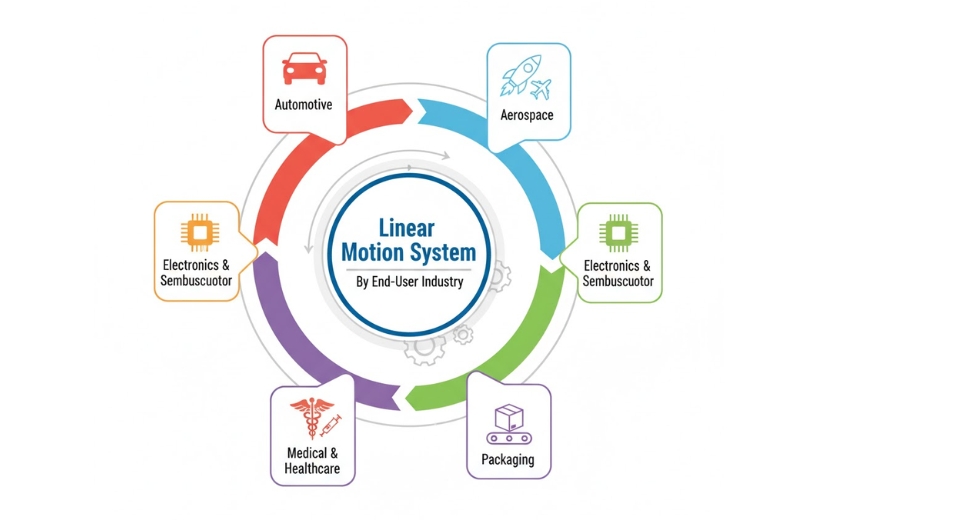MARKET OVERVIEW
The Global Ergonomic Mice market can be said to represent one market segment where the need is for devices that enhance comfort while relieving strain during extended hours of use on the computer. The market will continue to evolve as ergonomic alternatives to common computer mice attract increasing numbers of professionals, gamers, and recreational users concerned about potential musculoskeletal health issues emanating from repetitive hand movements. Ergonomically designed mice align with a more natural hand position, which reduces wrist tension and can eliminate the risk of developing carpal tunnel syndrome and repetitive strain injuries.
Such an advancement in technology guarantees a constant revolution in the Global Ergonomic Mice Market concerning the design and functionality. Manufacturers will be working to innovate with materials and tweak structures that would suit different gripping styles: palm grip, claw grip, and fingertip grip. Wireless, customizable buttons, and adjustable sensitivity will remain product developments' core pursuits as far away to satisfy the ergonomic mouse' requirements from all users from any industry. The demand for devices that are comfortable under prolonged use would determine the future of this market.
Ergonomic peripherals are steadily gaining importance among establishments and their employees, who are increasingly considering them for the workplace and home office equipment. The Global Ergonomic Mice market will be influenced by the paradigm shifts in work environments that call for prolonged computer engagement under remote or hybrid existence. Employee health and comfort considerations will guide companies' investments into ergonomic accessories. Design, programming, and data-heavy professionals will remain engaged in discovering an equal balance between precision and comfort within these computing tools, thus reiterating the presence relevance of ergonomic mice.
So much of the Global Ergonomics Mice Market will also change due to gaming application-related culture and trends. Competitive gamers need input devices that are accurate, responsive, and comfortable, and in that respect, ergonomics is an important purchase consideration for them. Features that allow customization, including programmable buttons, adjustable weights, and high-precision sensors, pave the way for product innovation in the segment. This will become strongly reinforced with the rising demand for ergonomic peripherals from the esports and gaming culture.
Relevant technological advancements in sustainable materials and production will be key determinants of the Global Ergonomic Mice Market. Product design choices will increasingly favor ecological materials, recyclability, and durability from users and businesses alike. Manufacturers will strive to make biodegradable plastics, energy-efficient components, and modular designs that increase product longevity. The shift to sustain Mr. Will definitely influence purchasing wherein more environmental-friendly ergonomic mice will witness more adopters.
AI and adaptively controlled technology will add another layer to the Global Ergonomic Mice Market. Learning about user behavior, such as dynamically adjusting sensitivity and providing haptic or tactile feedback, enhances usability and efficiency. AI-enabled customization empowers users to calibrate their input devices to their hand movements, giving further enhancements for ergonomics. Another trending incorporation feature may be applying biometric sensors for real-time ergonomic evaluation and personalized adjustments.
The market shall adapt to various regulatory guidelines and workplace health standards. These organizations dealing with occupational safety will engage in ergonomic assessments affecting the decision of purchase of peripherals that fit the recommended ergonomic standard. This alignment of the Global Ergonomic Mice Market remains relevant due to its close grasp of such developments ensuring that product designs will meet the stands set for health and safety.
As the technology, workplace culture, and user behaviors change, so will the Global Ergonomic Mice Market being one of the prominent niches of computing accessories. The advances in ergonomic mouse design, materials, and functionality will continue to remain relevant to those looking for comfort, efficiency, and long-term health benefits from their digital working life.
Global Ergonomic Mice market is estimated to reach $2236.3 Million by 2032; growing at a CAGR of 5.0% from 2025 to 2032.

GROWTH FACTORS
The global ergonomic mice market growth is well-supported by the burgeoning awareness of ergonomics in the workplace. Companies have started seeing the value of providing employees with means of working that maximize productivity with minimum health inconvenience. Another determinant is the popularity of remote work, triggering investments in comfortable and efficient peripherals. Therefore, manufacturers are producing goods for every taste, whether in vertical mouse and trackball design or even models with some personalization options. Positive user experience elevated by wireless usability, precise tracking, and programmable buttons is working to further enhance the appeal of these devices.
The demand for ergonomic mice will continue to rise as individuals are becoming conscious of comfort and efficiency in the workplace. With more hours of computer use, the need for devices is being felt that minimize stress on hand and wrist. The Global Ergonomic Mice market stands to gain from technological innovations for designs that are comfortable but with added features. Companies are striving to design mice that work in synergy with natural human hand movements so that it becomes unlikely to cause discomfort or long-lasting health hazards.
Another very influential factor in the turn of the market is technological development. Smart-sensor concepts, adjustable user grip designs, and customized AI will provide a tailored user experience. Some manufacturers are designing models that will track and analyze hand movements in real time and adjust their sensitivity and responsiveness based on the user demand. Such innovations will force ergonomic mice out of the comfort paradigm and into that of productivity and efficiency.
The above-favorable factors benefit the development of the terrific market for ergonomic mice. On the contrary, there are some hindrances that will work against the market growth. High production costs and selling prices for advanced ergonomic mice could limit adoption, especially among price-sensitive consumers. Most conventional designs still dominate the ergonomics mouse market, which could be a resistance from users to switch from traditional designs they are familiar with. However, once these users become aware of the benefits of ergonomics, demand will increase, and they will begin pressing manufacturers to produce the cheaper models.
The market will find windows for opportunities with increasing investments in research and development. Companies are expected to study new materials that yield ecological designs with an improved refreshing customization feature for a wider appeal. The whole ergonomics mouse rage is fast attracting attention now that health-oriented technologies are making their way into the profession and personal lifestyle. The Global Ergonomic Mice market will flourish as companies and individuals continue to seek comfort and efficiency, making bold strides to deliver innovative solutions for multiple user needs.
MARKET SEGMENTATION
By Type
Design and function will evolve greatly in the area of ergonomic mice. There is presently a trend toward vertical mice because they lend themselves to a more natural left or right hand position, avoiding undue pressure on the wrist. Precision and minimal arm movement will continue to attract users towards trackball mice that allow them to move the cursor without physically moving the device. Additional interested will turn to other types with features such as customization and wireless. Manufacturers will strengthen the entry of ergonomic attributes that promote comfort and technological advancement as more users acknowledge their long-term advantages.
The ergonomic mouse of the future should be smart, with built-in features that improve their efficiency and make them easier for the user. Sensitivity will be user-adjustable. Buttons can be programmed. Battery life is expected to last longer. The introduction of AI-driven customization, where the mouse adapts to a user’s hand movement patterns, is going to become a game-changer for the industry. Growing publicity about repetitive strain injury will make forays into material and shape designs that augment grip and promote longer-term support. Another aspect of developing products will include the rise of remote work and digital collaboration, which will mean that individuals are looking for high-performance peripherals that can support both professional and personal tasks.
The Global Ergonomic Mice market will also become a competitive ground as brands strive to provide unique features. Development will see the trialing of new materials with a focus on durability while minimizing weight. Wireless technology will see accelerated developments toward faster response times and reliable connectivity. Sustainability will be a major guiding factor in product development toward eco-friendly designs that cater to consumers that are green-conscious.
Instead of offering comfort, ergonomic mice will become the interface between technology and the user through smart features. The emergence of smart technology, new materials, and personalization will set the new standards in the sector. Increased product options will thus enable consumers to choose with comfort and efficiency in mind. By Connectivity the market is divided into Wired, Wireless.
By End User
As people have started to realize the advantages of comfortable and efficient work setups, the demand for ergonomic mice is anticipated to grow. While the issues of wrist strain, discomfort, and long-term health repercussions after sitting for long hours at a computer have become magnified, users are increasingly being driven to solutions that enhance these daily experiences. The Global Ergonomic Mice market shall keep growing, aided by technological advancements in creating niche products aimed at addressing different user requirements. The emphasis has been towards designs that will not only lessen strain but also offer precision and responsiveness attractive for both corporate and private use.
Future innovations will bring more features beyond comfort. Smart sensors, customizable buttons, and wireless connectivity will become the norm, giving users the freedom to configure their devices for better control. Advanced tracking technology will provide smoother cursor movement on the computer screen regardless of the surface used. Longer battery life with sustainable materials will be appealing to the green-minded consumer. Demand for artificial intelligence integration will allow a mouse to adjust sensitivity and button functions based on user patterns.
The Global Ergonomic Mice market will continue to embrace the changed needs of different users on account of ongoing developments. Individual users will seek products that conform to their routines, offering ease of use coupled with comfort that can last for years. Professional gamers will demand maximum performance, with enhanced accuracy, programmability, and quick response. For the office worker, it is all about relieving wrist strain and maximizing efficiency at work. In turn, this demand will continue to rise as remote work and flexible office arrangements become ever more common.
As this competition heats up, companies will compete to refine products to the precise specifications. Customizability, lightweight design, and efficient connectivity will be critical to the next-generation products. Manufacturers will seek to put ergonomic shapes across multiple sizes and grip styles into the hands of their customers to give the best possible experience. A concept of wireless convenience shall gain traction, backed up by better charging systems and batteries that last for long periods.
As technology will continue to develop, the Global Ergonomic Mice market will change in a direction where users' expectations are altering. Health and efficiency are areas that would pour tremendous influence into the design and smart features. With constant refinements being carried out by the companies, consumers expect these devices will deliver a comfortable, useful, adaptable mode of work and play. This healthy process will ensure the prevalence of ergonomic mice in digital interfaces, having a firm grip on productivity and well-being.
By Distribution Channel
Today, ergonomic mice will continue to grow as more and more people realize the need for comfort and efficiency in the constant use of computers. Many professionals and gamers are looking for devices that can reduce strain on their hands and wrists, and that concern has led to greater focus on innovative designs increasing the Global Ergonomic Mice market as technology improves and manufacturers are able to create products with the needs of these different categories in mind-whether work, play, or general use.
Many of the companies are trying to evolve different characteristics in various aspects such as grip, customizable features, and connectivity. Wireless technology will take a huge part of these products in future, as most users are more oriented to freedom-hand movement instead of the traditional wired one. Senses will again increase the accuracy, giving ergonomic mice even more appeal to professionals whose work needs exactitudes. Other features will include smart functions like program buttons, adaptive sensitivity, and AI driven alterations. These will enable users to keep a more natural hand position to minimize weariness and lower the chances of discomfort over the long term.
The Global Ergonomic Mice market is segmented on the basis of distribution channel as online retailers and offline retail shops. Online platforms will keep playing a key role in sales, as the trends of consumers are continually heading more to the browsing convenience with all options, reading customer reviews, and price comparison before any purchase. E-commerce platforms will also provide greater variety of choices alongside offers and speedy deliveries. Subscription-based buying models and personalized recommendations will also define future trends in engaging buyers with online stores.
Of course, the majority of the sales occur through online channels, but offline retail stores will also play a significant role in the market. Testimony also abounds that many customers prefer to test a product before purchasing it. This is especially true for comfort-based devices like ergonomic mice. What will happen to retail stores is that they will offer in-person experience to consumers in order to try out different designs and receive advice from sales representatives. Adding to this, physical stores will also provide after-sale support which is going to be a key factor of attraction for buyers valuing direct customer service.
As under-technology brink, the Global Ergonomics Mice market would flourish in the future as getting smarter and more comfortable designs. There will be many competing manufacturers who would even bring down costs without the devices actually straining productive outputs. This balance of online and off definitions from which consumers can explore and procure items tailored to meet their needs is a certain feature of the market. In the course of constant innovations, future ergonomic mice promise to keep bringing in even better comfort and efficiency in use.
|
Forecast Period |
2025-2032 |
|
Market Size in 2025 |
$1589.0 million |
|
Market Size by 2032 |
$2236.3 Million |
|
Growth Rate from 2025 to 2032 |
8.3% |
|
Base Year |
2024 |
|
Regions Covered |
North America, Europe, Asia-Pacific, South America, Middle East & Africa |
REGIONAL ANALYSIS
After 2023, the demand for ergonomic mice is anticipated to increase, with more people emphasizing comfort and long-term health while using computers. With an increasing focus on the reduction of strain-triggered injuries, companies and consumers alike are on the lookout for devices that provide better support to the hand and wrist. The Global Ergonomic Mice market will keep evolving with new designs introduced by manufacturers who are attuning to different needs from users. Technology advances will play a vital role in the evolution of enhanced customization, wireless connection, and accuracy in movement tracking.
The needs and levels of technological acceptance of different regions are going to determine the market. Among other reasons, the North American market will be a strong one since people are much aware of workplace ergonomics, and a high number of professionals work long hours in front of the computers there. Steady demand will be seen mostly from the U.S., Canada, and Mexico for the ergonomic mice, with companies and individuals purchasing devices to promote better posture and reduce discomfort. In Europe, the UK, Germany, France, and Italy will promote the growth of the ergonomic mice market, with increased awareness of ergonomics in offices and home workplaces. As more companies push for employee wellness, there will also be an increasing demand for ergonomic aids that create higher productivity at comfort.
Asia-Pacific will play an eminent role in the Global Ergonomic Mice market in the future. The countries- China, Japan, South Korea, and India-will contribute to market expansion, aided by technology adoption and a rise in the consummation of remote office setups. There will be high demand for new, advanced, and reasonably priced ergonomic solutions to induce companies to manufacture products targeting a wider range of consumers. The need for comfort and efficiency in peripherals among employees working remotely is poised to get increasingly stronger.
South America, particularly Brazil and Argentina, will see drifting adoption as awareness of the benefits of ergonomic devices gradually spread. With a growing population of its workforce putting software applications to task for prolonged periods, companies and individuals shall seek products that can help relieve strain and discomfort. The Middle East and Africa zone shall also embrace growth, especially in areas that include the GCC Countries, Egypt, and South Africa, where the technology infrastructure is burgeoning and increasing numbers of organizations are concerned about workplace well-being.
As ergonomic technology advances, the manufacturers will be influenced in the design and marketing of their products by the regional markets. Companies will start to manufacture ergonomically designed mice in accordance with user preferences which will include customizable buttons, improved grip designs, and smart sensors. With greater awareness on the impact of long-term computer use on health, the demand for ergonomic solutions will continue to characterize the industry's future.

COMPETITIVE PLAYERS
Key players operating in the Ergonomic Mice industry include Logitech, Microsoft Corporation, Razer Inc., Anker, Swiftpoint Limited, SteelSeries, Evoluent, HP Inc., ASUSTeK Computer Inc., 3M Company, Delux Technology, Adesso Inc., TeckNet, Trust International B.V., Goldtouch, Contour Design, J-Tech Digital, Inc., VicTsing.
Ergonomic Mice Market Key Segments:
By Type
- Vertical Mice
- Trackball Mice
- Other
By Connectivity
- Wired
- Wireless
By End User
- Individual Users
- Professional Gamers
- Office Workers
By Distribution Channel
- Online Retailers
- Offline Retail Stores
Key Global Ergonomic Mice Industry Players
- Logitech
- Microsoft Corporation
- Razer Inc.
- Anker
- Swiftpoint Limited
- SteelSeries
- Evoluent
- HP Inc.
- ASUSTeK Computer Inc.
- 3M Company
- Delux Technology
- Adesso Inc.
- TeckNet
- Trust International B.V.
- Goldtouch
WHAT REPORT PROVIDES
- Full in-depth analysis of the parent Industry
- Important changes in market and its dynamics
- Segmentation details of the market
- Former, on-going, and projected market analysis in terms of volume and value
- Assessment of niche industry developments
- Market share analysis
- Key strategies of major players
- Emerging segments and regional growth potential







 US: +1 3023308252
US: +1 3023308252






